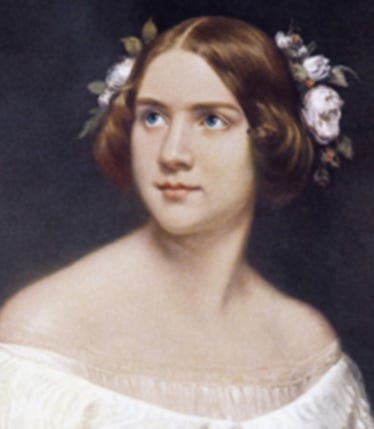In London’s Wembley Stadium this weekend, a thirty-four-year-old singer will entertain audiences with songs like “Cruel Summer,” “My Tears Ricochet,” and “You Need to Calm Down.” Her name is Taylor Swift. Her nine-month Eras Tour is expected to gross more than a billion dollars. Tickets have changed hands for as much as $10,000 each. More than 22 million fans joined the virtual line to gain admission to a Swift appearance in Singapore.
Amazing! But even in an era when the heights of fame seem impossible to scale without supplemental oxygen, Swift’s notoriety does have its echoes in the past. Before there was Swift Mania there was Lind Mania.
Jenny Lind was a renowned nineteenth-century opera singer known as the “Swedish Nightingale.” Born in 1820 to a single mother, she began her musical training at ten and debuted at eighteen. Her voice possessed a magical quality that entranced audiences. Hans Christian Andersen, the Danish author of fairy tales, said, “Through Jenny Lind, I first became sensible of the holiness of Art.” Although the singer rejected his proffers of love, Andersen’s story “The Nightingale” helped establish her reputation.
Lind was swarmed by fans in England, where she performed before Queen Victoria. In 1849 she announced her retirement after ten years on the stage. But that same year she was approached by the American impresario Phineas T. Barnum with an offer to tour America. Hoping to raise money for charity, she demanded $187,000 (about $7.5 million in today’s currency) for 150 concerts. In cash. In advance.
Barnum, who had never heard her sing, mortgaged everything he owned and borrowed more to front the fee. He had faith in his own ability to turn “Jenny Lind” into a household word. He calculated that her immense musical talent, combined with her “charity, simplicity, and goodness personified,” would attract paying customers.
The key ingredient, ballyhoo, was Barnum’s forte. His advance publicity made her so famous that more than forty thousand fans turned out to catch a glimpse of her when she stepped off the boat at New York City in September 1850. A reporter noted that she was greeted by “the maddest of all madness.” The New York Herald called her simply “the most popular woman in the world.”
Today, you can buy Taylor Swift hooded sweatshirts, pajama pants, bookends, dolls, guitar picks, mugs, and water bottles. But she didn’t invent “merch.” In 1850, you could pick up Jenny Lind bonnets, furniture, cravats, gloves, handkerchiefs, soap, cigars, glassware, and pianos.
When Lind found out how much Barnum stood to make, she demanded her share. A new contract gave her all the profits from each concert after the promoter took his fee of $5,500. So intense was the demand for tickets that Barnum had taken to auctioning them off for astronomical prices. One sold for $225 ($9,000 today). At the height of the mania, he was charging money just to get into the auction and have a chance at bidding.
How can we explain the adoration of Jenny Lind or of any celebrity? Certainly she could sing – the composer Felix Mendelssohn said she had a once-in-a-century voice. And the media definitely played a big role. Penny newspapers had been introduced in the 1830s — they competed with each other to push the latest fad. Correspondents gushed over Lind’s “unique and original warbling.”
Humans, then as now, were eager to see their own talents and virtues writ large on the great stage of history. Barnum understood that Lind’s fame was fueled not just by the high notes that she could hit, but by the high virtues that she represented. She personified the good that all saw in themselves — many were willing to pay a steep price to be in her presence.
In June 1851, part way through the tour, Lind and Barnum came to an amicable agreement to end their contract. He had already made at least $500,000 in profit ($20 million today), and she had tired of his relentless promotion. She managed the rest of the tour herself. She added Canada to her itinerary—tickets for her Toronto concert sold out in ninety minutes. Lind insisted on offering some seats for a dollar or two to give a wider audience a chance to see her.
Taylor Swift is the first musician to earn a billion dollars just on her songwriting and performing. She gives generously to food banks, libraries, and many other causes. In this, she follows in the footsteps of Jenny Lind, who pledged all of her tour fees to charity. In particular, she helped finance free schools in her native Sweden.
Today in America, many streets, churches, parks and concert halls commemorate Lind’s tour, and you can visit three towns named for her. Emily Dickinson, who was twenty when she saw Lind sing, said, “Herself and not her music was what we seemed to love.”
Or, as Taylor Swift says, “Being good to people is a wonderful legacy to leave behind.”
There are no recordings of Jenny Lind, but this rendition of Bellini’s “Casta Diva,” one of the arias Lind included in her programs (here sung by the incomparable Renée Fleming) might give an idea of the Nightingale’s brilliance. Click HERE to listen.
A reader recently commented about God Save Benedict Arnold on Amazon: “Reads like an adventure novel. Gripping, entertaining, fascinating, engaging and highly informative.” Great summer reading! Click HERE or on the image below to have a chance at buying a signed copy. Don’t wait.









Thank you, Jack. Too bad we can’t hear how beautiful her singing must have been. Renee Fleming is one of our favorites.
Amazed, I am.